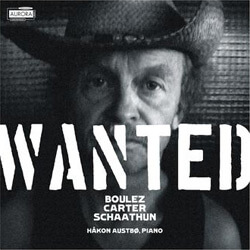 Three composers – each aiming to create modern music in which form has been replaced by “structures” – are featured on this Aurora CD of piano music performed by Håkon Austbø. When does one listen to atonal music? In the morning while sipping coffee over a NY Times detailing the latest fabricated Iranian “threat”? Perhaps while running on the treadmill at the gym and looking up at Anderson Cooper reporting on the latest school shooting? Maybe at the checkout line at Wholefoods with a basket full of organic beet juice? The answer to all of these is yes: as we are continuously mesmerized by the last gasps of an unraveling empire, these various incarnations of serial piano music are the medicines to free us, and deliver us back to a spiritual tabula rasa, an unpolluted universe of pure sensory potential.
Three composers – each aiming to create modern music in which form has been replaced by “structures” – are featured on this Aurora CD of piano music performed by Håkon Austbø. When does one listen to atonal music? In the morning while sipping coffee over a NY Times detailing the latest fabricated Iranian “threat”? Perhaps while running on the treadmill at the gym and looking up at Anderson Cooper reporting on the latest school shooting? Maybe at the checkout line at Wholefoods with a basket full of organic beet juice? The answer to all of these is yes: as we are continuously mesmerized by the last gasps of an unraveling empire, these various incarnations of serial piano music are the medicines to free us, and deliver us back to a spiritual tabula rasa, an unpolluted universe of pure sensory potential.

Håkon Austbø – Photo Edwin Roelofs
The third piano sonata of Pierre Boulez is an unfinished work, or as Håkon Austbø describes it, “a work in progress.” It originally was to consist of five “formants” (as opposed to movements from a traditional sonata) but only the second, “Trope,” and third, “Constellation – Miroir”, were published and appear here in that order. You see, this is aleatoric music, though a more tightly-controlled variety than that composed by John Cage. The pianist must choose in which order to play the formant’s sections (in Trope: Texte, Parenthèse, Glose, and Commentaire, but only 8 possible orders), “whether or not to play structures placed inside parentheses,” and how to distribute “notes indicated to be played freely within a given time-span.” Traditionally, the order of movements in a sonata is fixed, and the relationship between these movements is established by changes in key and tempo; thus a kind of narrative is established. The concept of “choice” during a performance is not, however, entirely new. Every time a performer comes on stage for an encore, that performer makes a choice of what to append to the program. Here, though, the idea of a narrative is completely done away with, and instead, in the words of the composer, the work resembles “the plan of a city… there are different ways of going through it… but there are certain traffic regulations.
The pianist begins in a way that doesn’t sound like a beginning at all. Since this is twelve-tone music, the tone-feed is rather balanced throughout, and dramatic moments are achieved primarily through abrupt changes in register and dynamics. The influence of Webern is frequently felt in the work of Boulez, and here as well. The absence of rhythmic patterns or harmonic hierarchy means that even the appearance of a consonant interval like a minor third does not serve as a rest stop, or a reward, but rather a somewhat more tidy corner in Boulez’s city. The end of Trope, however, is clearly identified, as the last vertical sonority is sustained and allowed to decay naturally.
I found myself discovering that while I associate certain types of music with certain moods (heartbreak? give me Tom Waits), this atonal piano sonata is something that takes me completely out of any emotional context. Every person interprets a piece of music in a personal way, and for me, I find that Boulez is a trustworthy escape from this age of ours, which I like to call post-empire. Though the piece is from 1957, the unraveling of the west’s global dominance has been going on for some time, and though popular music has tried to respond to historical changes (flower power, punk, etc), I feel that what is needed is simply a musical epigram for a generation self-incarcerated in countless stupid little computer devices. Several such epigrams are provided by the Blocs and Points of the sonata’s second formant, Constellation – Miroir (so named because it is published in retrograde form, and hey, who hasn’t played a record backwards to try and find evidence of artistic transgression?). The pointilistic patter of hard-stuck piano notes could easily be taken for the ping of 0’s and 1’s which light up our post-empire world with videos of cats flushing toilets. This is truly music for music’s sake and is in any event an excellent showcase of Austbø’s skill in articulation on the piano. At times the damper pedal is depressed just after a staccato attack, resulting in an eery, corrupted reverb.

Håkon Austbø – Photos Håkon Styri
Elliot Carter describes Night Fantasies (1980) as “suggesting the fleeting thoughts and feelings that pass through the mind during a period of wakefulness at night… when it is not dominated by strong, directive intentions or desires – to capture the poetic moodiness… of Schumann[’s] Carnaval and Davidsbündlertänze.” This is interesting: Schumann dominated the Romantic piano literature of so-called character pieces, a major departure form the regime of the sonata. And just as Boulez has turned the sonata into structural labyrinth, Carter uses 88 “all-interval” 12-tone chords in order to evoke the panoply of impressions that take shape in our minds during a bout of insomnia. Perhaps we think very highly of ourselves during daytime, when we are in control with our impressive array of communication networks and organizational tools. But who has not experienced the sheer terror of a sleepless night, when the mind is unloosed in the darkness, penumbral fears coalesce, memories become contaminated with fancy and the subconscious, bloated with putrefaction, floats to the surface? Nighttime is no escape in the post-empire age, and Carter uses the piano as an EKG, interpreting the feverish ruminations of middle-class discontent, as well as the somber resignation that the year-end bonus has not brought happiness, after all. Indeed, the flux between stark lento passages and flighty, fugue-like flurries on the piano is handled with great control by Austbø, and delineates a fascinating, paradoxical compromise between rigid constraint and freedom.
 Asbjørn Schaathun’s Physis for amplified piano and five digital harmonizers (1986/2003) consists of seven “areas,” each of which consists of a main section without electronics, followed by smaller sections using the digital harmonizers, which attach a very attractive shimmer to the sonorities of the piano, and also seem to sometimes compress the sound into dense, buzzing nodes of energy. As with the Boulez sonata, the performer chooses the order of these smaller sections. Austbø points out in the liner notes that “the electronic component of the piece… has been subject to revision… as technology has evolved.” Some of the parameters resemble ring modulators, sweeping through overtones and tapering off like the tail of a sonic comet. Some parameters are controlled by the performer, making the end product a true collaboration with the composer. Many of the scale fragments, winding up tightly and exploding in crashing chords, reduce form to a very small scale; the listener is captivated by the gravity of the present, no longer affected by the arresting events of just a few moments before.
Asbjørn Schaathun’s Physis for amplified piano and five digital harmonizers (1986/2003) consists of seven “areas,” each of which consists of a main section without electronics, followed by smaller sections using the digital harmonizers, which attach a very attractive shimmer to the sonorities of the piano, and also seem to sometimes compress the sound into dense, buzzing nodes of energy. As with the Boulez sonata, the performer chooses the order of these smaller sections. Austbø points out in the liner notes that “the electronic component of the piece… has been subject to revision… as technology has evolved.” Some of the parameters resemble ring modulators, sweeping through overtones and tapering off like the tail of a sonic comet. Some parameters are controlled by the performer, making the end product a true collaboration with the composer. Many of the scale fragments, winding up tightly and exploding in crashing chords, reduce form to a very small scale; the listener is captivated by the gravity of the present, no longer affected by the arresting events of just a few moments before.
The resulting soundscapes are, in my opinion, like the Boulez, escapes from a world where we are accustomed to receive satisfaction at the click of a button, or escape disconcerting news at the click of another button, or just click buttons with glazed-over eyes because that’s all that we do anymore. I could compare Schaathun’s music to the drawings and sculpture of Roni Horn, but what would be the point? True artists and musicians have responded to their fractured disciplines and the loss of stylistic movements in the post-empire age by creating processes that aim neither to please nor to impress, but simply to exist as testaments to a sensory world which, while polluted with over-consumption and cursed by self-imposed cultural sterility, retains the potential to receive new modes of expression. Perhaps these artists are ushering a new age – one of intelligent design.
—
Rob Wendt is a pianist / composer / music educator living in Astoria, NY. You can follow him on twitter: @RobWendt




















